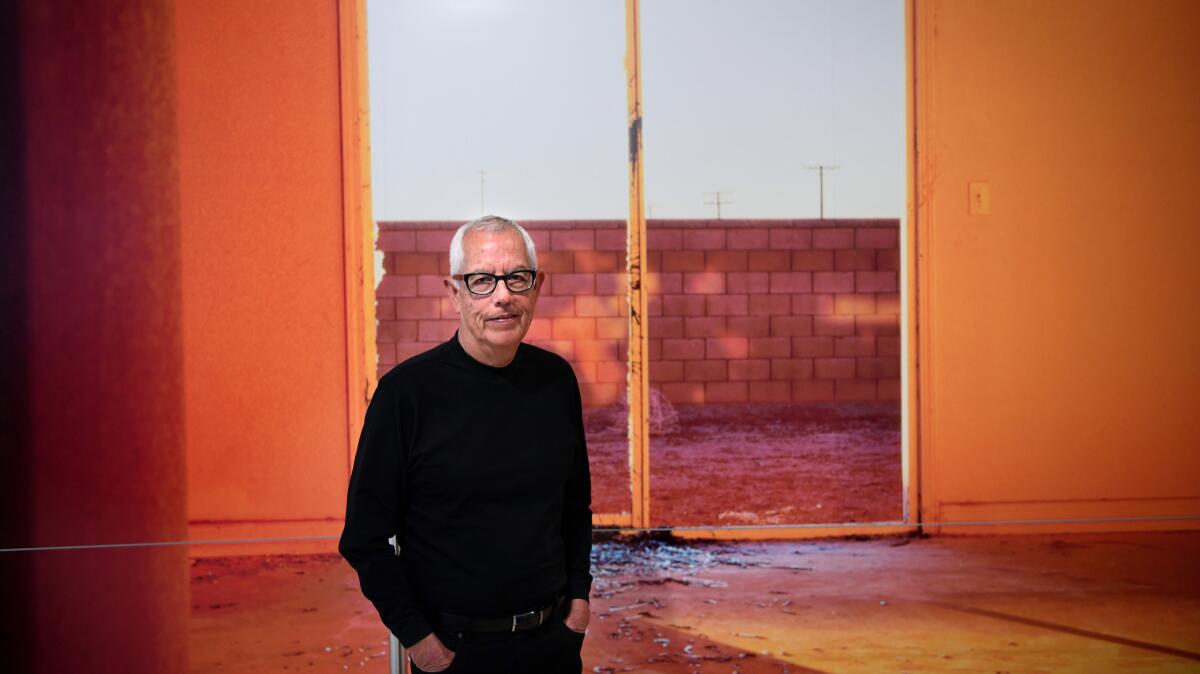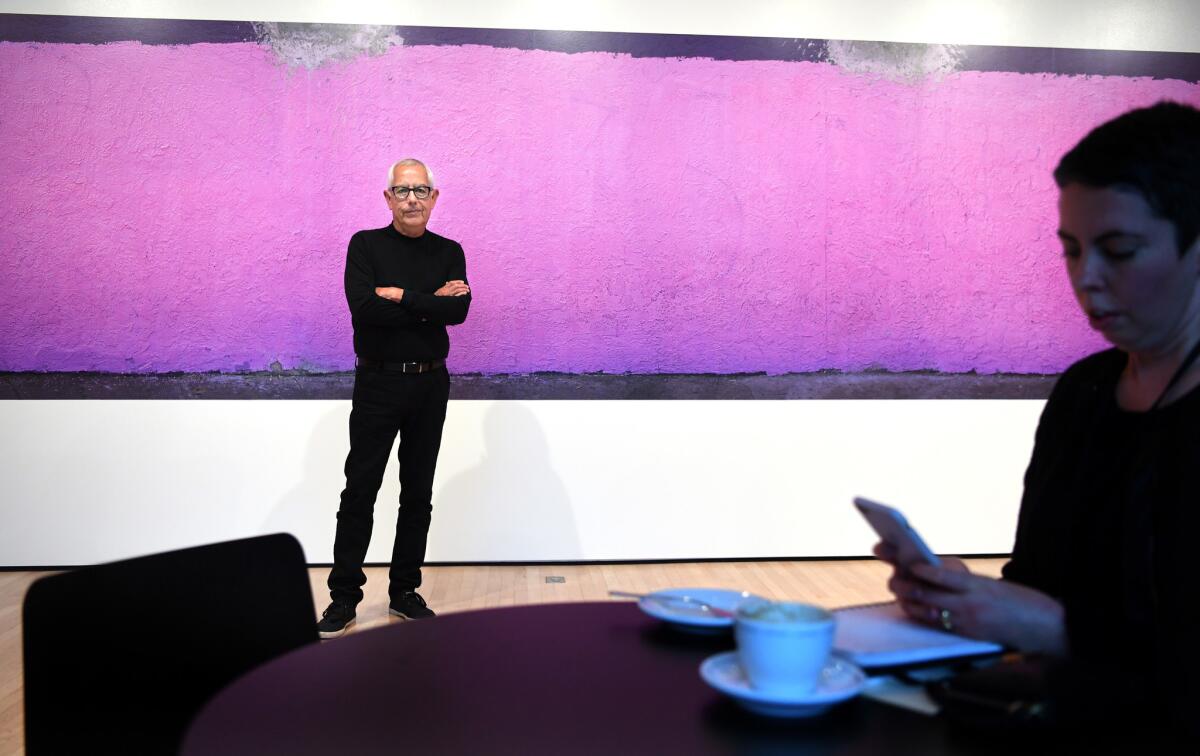Photographyâs best-kept secret: How Anthony Hernandez put a distinctly Los Angeles lens on picture-making

They are images in which Los Angeles can see itself, the side that doesnât make it onto the picture postcards: Broken-down trucks in wide empty lots, the improvised architecture of freeway-side homeless encampments and municipal spaces that seem to offer their residents little more than disdain.
In the photographs of Anthony Hernandez, there are no swaying palm trees or cinematic sunsets. Instead, for half a century, this born-and-bred Angeleno has trained his unblinking lens on another L.A. â a city of the aged, of the working class, of the destitute.
âCities are hard places,â the low-key Hernandez says of his work. âTheyâre not very accommodating, especially Los Angeles.â
For much of the 20th century, street photography was often associated with the dense cities of Europe and the Northeastern United States â particularly New York, where figures such as Diane Arbus, Bruce Davidson and Helen Levitt elevated the act of the impromptu street shot into high art. But Hernandez â now 69, and looking stately with a crown of white hair â helped give the form a distinctly Los Angeles cast.
âWhat Anthony did is to think about what street photography would mean in Los Angeles,â says Erin OâToole, associate curator of photography at the San Francisco Museum of Modern Art. âHe taps into the geography, into the way people use the streets, the way that they function in public.â For the last half-dozen years, OâToole, also born and raised in Los Angeles, has been organizing Hernandezâs first-ever museum retrospective, which opens at SFMOMA this weekend.
More than 120 images will be on display â early street photographs shot around downtown, abstracted vistas of homeless encampments and the so-called Automotive Landscapes, black-and-white pictures that depict the un-sexy side of car culture.
âHe has created something completely unique that is geared at the urban landscape of Los Angeles â that openness,â says OâToole, âwhich can be daunting if youâre trying to make street photography in a New York way.â
Hernandez didnât set out to re-imagine street photography when he first picked up a camera as a teenager in the late 1960s.
âThe reason I started photographing in downtown Los Angeles was not because of the work of other street photographers,â he says. âItâs because I grew up there. Naturally, if Iâm going to take pictures, Iâm going to take pictures of places I know.â
That knowledge â of Los Angelesâ functions and dysfunctions â translated into a staggering array of work that almost immediately caught the attention of the art world when it emerged in the 1970s.
Yet Hernandez, widely admired within the photographic community, is little known by the general public. OâToole says some of that may have to do with the fact that Hernandez doesnât teach and receive the institutional support other artists have.
But some of it may have to do with the photographerâs nature: quiet, retiring, not the sort to tell swashbuckling tales about crawling around homeless encampments with a large-format camera, though that is what he does.
Sign up for our weekly Essential Arts & Culture newsletter Âť

On a trip to New York in the 1970s, he met the legendary Arbus for lunch at a coffee shop.
âShe was concerned, asking, âHow are you making a living?â â he recalls. âI was 22 or 23. I wasnât making a living. She said, âYou should try and get magazine work.â She said, âWhen you meet somebody, you canât stop talking. Just keep talking.â I said, âWhat do you mean?â She said, âDonât stop talking, and they will give you some work.â â
âI never did it,â Hernandez says with a modest smile. âI was a little too shy at that point to be out there trying to hustle to become a commercial photographer.â
Unruly days
Some people know they are going to be artists their whole lives. Not Hernandez.
He grew up on L.A.âs Eastside â in Aliso Village, then Boyle Heights â the son of a machinist and meatpacking worker. As a teen, he was unruly; for a time, he ran with a local gang. But during his senior year at Roosevelt High School, a friend gave him a photography manual heâd found in the bathroom at East Los Angeles College.
âI didnât know anything about art and I had no interest in going to college,â says Hernandez, seated over a cup of coffee by a mural-sized print of his work at SFMOMA. âThe idea of photography â the only thing I could think of was maybe Iâd become a fashion photographer and I would make a lot of money and meet a lot of beautiful women.â
He enrolled in a photo course and was seduced by the process â âwhen you go in the dark room and make your first print, itâs magical.â Then he found the work of Edward Weston, the early 20th century lensman known for his sensuous still lifes and nudes.
âI discovered Edward Westonâs bookâ recalls Hernandez. âThey were these little brochures, but with high-quality reproductions ⌠His work was a big inspiration.â
Hernandez realized he wanted to make art, but âthe instructors at East L.A. College, they were trying to get people interested in photography to make a living. When I found Weston, I realized they couldnât help me.â
He began to experiment with street photography, capturing a young woman hanging out under a bridge and a pair of taciturn young Mexican men at a bus station.
In 1967, he dropped out and hitchhiked to New York â where he visited museums and went to jazz concerts, even catching a gig by Miles Davis. But soon after he landed, his mother informed him that his draft papers had arrived. He was going to Vietnam.
During the war, Hernandez worked as a medic. (âThat experience, you realize life is very fragile,â he says.) He nurtured his artistic dreams with a subscription to Artforum, sent by his Aunt Dolores, who supported her nephewâs creative ambitions.
âWhen you leave, the Army gives you this wooden box, and itâs locked, and you put your things in there and they ship it back to the States,â he says. âI put all my Artforums in there.â
Back in the U.S., Hernandez pursued photography with renewed zeal. He settled near MacArthur Park (where he and his wife, novelist Judith Freeman, still live) and devoted himself to capturing the fleeting public-private moments of L.A. dwellers: a man observing his reflection in a store window; a group of young women staring warily at his lens.
Inspired by Westonâs photos of a nude figure on a beach, he too hit the coast â but instead of sun and surf, he delivered unflinching reality: the sprawled figures of recreational sunbathers and homeless alike, in poses that are at once feral and contorted.
By the early â70s, his work had caught the eye of John Szarkowski, the influential photography curator at New Yorkâs Museum of Modern Art, who arranged for him to meet Arbus and Garry Winogrand. But one of Hernandezâs biggest breakthroughs came in the late 1970s, when he turned his attention to cars â or, more accurately, the industrial sites that surround them: garages, junkyards, body shops. âI started thinking about what else I could do in L.A.,â says Hernandez. âWell, L.A. is an automotive landscape.â
And it was one he knew intimately. Before he became a regular recipient of grants and residencies, the artist worked odd jobs, including sanding cars at a body shop off Figueroa.
Hernandezâs innovation with the auto series also lay in his approach. In the late â70s, he swapped out his 35mm, good for stealing quick on-the-street images, for a large-format 5x7 Deardorff that checked in at roughly seven pounds â not counting the tripod required to balance it.
Itâs a downright impractical camera for taking street pictures, but Hernandez got it down to a science. âI could take a picture in a minute,â he says. âIf it didnât look interesting, I keep walking.â
And walking was a big part of it â around Hollywood, downtown and L.A.âs industrial guts, hauling the Deardorff with him wherever he went. âOne day, I walked from Santa Monica to where LACMA is, photographing,â he recalls. âThen I got tired and took the bus home.â
The effort was worth it. The larger Deardorff negative could record wider spaces at a greater resolution, allowing Hernandez to shoot broad panoramas without losing detail. This had the effect of making his images of L.A.âs industrial sprawl look almost painterly, even when the focus was unforgiving grit.
In one photograph, from 1978, he captured an expired ice cream truck in a junkyard, its friendly form at sea in an ocean of automotive refuse. Behind it, electrical towers loom through a gray haze. You can practically smell the grease.
âOther artists were interested in car culture, but they depicted shiny cars and speed,â says OâToole. âThis was about dead cars or cars that they are trying to revive. Itâs what you see in a lot of his bodies of work â places that are overlooked.â
As Hernandez scoured the city for automotive sites, he began to photograph people at bus stops: Seniors, members of the working class, milling about at unsheltered stops alongside garbage-strewn hillsides and bare industrial streets.
Says Hernandez: âItâs looking at how people use Los Angeles or donât use Los Angeles.â
This is a theme that unites many of the series he has produced since â in particular, the multiple projects he has devoted to exploring the grim living conditions of the homeless.
One 1988 image features the poignant sight of a prim new pair of shoes sitting alongside a filthy mattress. Another, from 2010, shows a concrete wall covered in blistering paint, an image taken from the point of view of the individual who might have lain beside it. It is shelter of the coldest, grimmest sort.
OâToole says that combing through Hernandezâs archive to organize the retrospective revealed an artist who is âconstantly forcing himself out of his comfort zone.â
That is something he hasnât stopped doing. Heâs currently at work on another Los Angeles series, in which he employs the architecture of bus shelters to create abstracted city scenes.
âSomeone said â I think it was Joan Didion â that to âgetâ Los Angeles, you need a pair of sunglasses and to like to drive,â says Hernandez. âI would say thatâs completely wrong. You may need the sunglasses. But you donât need the car. You need to walk.â
Where: San Francisco Museum of Modern Art, 151 3rd St., San Francisco
When: Opens Saturday and runs through Jan. 1
Info: sfmoma.org
Twitter: @cmonstah.
ALSO:
âThe Vermeer of Los Angelesâ? Slow-art champion Tom Knechtel lets us in the studio
Q&A: Pure color: A curatorâs new view of Helen Frankenthalerâs unprimed legacy
Larry Clark turns life into art for photo exhibit at new United Talent Agency gallery
How Trump isnât the first to use âLes Miserablesâ music as a political rallying cry
More to Read
The biggest entertainment stories
Get our big stories about Hollywood, film, television, music, arts, culture and more right in your inbox as soon as they publish.
You may occasionally receive promotional content from the Los Angeles Times.











